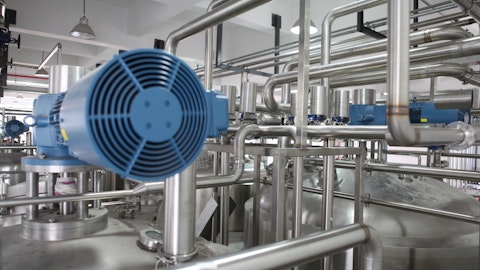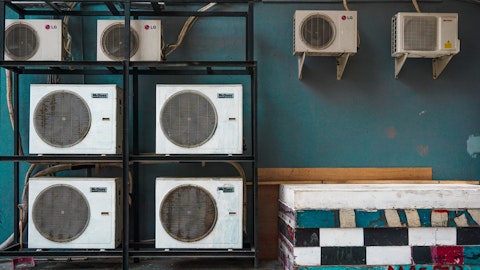David Gitlin : Yes. I think, look, there’s been some skeptics on the — whether we see the 15% to 20% over 2 years. We’re very confident in that. We are going to increase price in resi. The normal price that we would have done anyway. We will continue to do that. As we go into next year, and we’ll do it again in early 2025 as well. And then on top of that, you are adding some cost to the system for things like leak detection and sensors and some parts of the controls, and it would only be natural for us to increase price based on some of the additional protections that we’re adding to the 454-B units. So we came into this year expecting price and mix benefit. I think it will turn out to be even slightly higher than we thought, around 10%. And we expect to see kind of similar orders of magnitude on price mix benefit with the 454-B unit.
Operator: Our next question comes from Brett Linzey with Mizuho.
Brett Linzey : Yes. I just wanted to come back to the business exit update slide. You noted the resi commercial fire public trading late spring. Was hoping you could just put a finer point on what the nature and structure of that transaction might look like as it moves to the public markets?
David Gitlin : Brett, it could take a few different forms. Look, it could be a spin. It could be a split. We — the example there would be J&J can view that was in the market recently. So that’s an example that we benchmarked. We’re preparing for different scenarios. And look, we’ve talked about a clean exit. We’ve talked about accelerating buyback. We’ve talked about our commitment to our investors to pay down debt. And what we’re doing with this public company exit is achieving, yes, all of the above. So we’ll work on the specific form as we get into early next year. The prep is the same effectively either way. And I’m very proud of the team because normally, a lot of this work would take longer. But the team is heads down working around the clock so we can be ready for public trading in the late spring of next year.
Brett Linzey : Okay. Yes, makes sense. And just to follow up on the international truck and trailer sales up over 20%, strong quarter. A bit of a moderation in the order book. What is your level of visibility based on backlog, based on incoming order rates as we flip the calendar here to ’24?
David Gitlin : Well, there’s a couple of factors going on with international truck trailer. You also have a very rapid transition to electric going on there as well on truck. So I would tell you, we were pleasantly surprised with the low double-digit kind of increase — the increase that we saw overall in international truck trailer. Orders were up 60% in the third quarter for our international truck trailer business, partly because of this transition to some of the electrification and partly because of the team has done very well in supporting the customers and the overall market demand. So we feel well positioned going into next year on the European truck trailer and even China has done well for us on the truck trailer side.
And then North America truck trailer, despite people can sort of focus on some of the ACT numbers. But people said, look, 2023 ATP down mid-single digits for the year, our North American truck trailer will be up double digits. So we’re taking a sober look at what ACT is saying for next year, but there’s a lot of countervailing forces between, again, the shift to electrification, price, mix, and then this overall focus that we’ve had globally on length and more digitally enabled recurring revenues has yielded a lot of very strong results for us.
Operator: Our next question comes from Nigel Coe with Wolfe Research.
Nigel Coe : So I think you called out, I mean, we haven’t explored this year, but the Toshiba performance, I think you called out, I think it’s on Slide 4, I think it was maybe Slide 5 — no, Slide 3. Toshiba Carrier performance remains strong. And we know Europe right now is really weak. We know that parts of APAC is really weak. So just curious what’s driving the upside performance at Carrier, Toshiba Carrier?
PatrickGoris: Nigel, the financial performance at Toshiba Carrier has been really strong. A lot of that is driven by the synergies. We mentioned, I think, last quarter that we’re increasing the cost synergies from a target of $100 million run rate to $200 million. It is helping us significantly expand our margins in that business. To your point, the sales in Europe for that business were a little lighter for Global Comfort solutions. But the performance overall for that business is really strong. And the key driver there is really all the synergies that the team is driving. And we are nowhere near the actual run rate yet. And so we expect to benefit from that for the next couple of years as that expands.
Nigel Coe : Okay. That’s great. That’s great to hear. And then I hate to go back to a question that’s been asked a couple of times. But obviously, the HVAC margins this quarter were spectacularly strong when we even move back out the tax item. Obviously, 4Q, and I think 4Q originally was meant to be sort of similar to 1Q. It looks like it’s coming in maybe a little bit weaker than 1Q. So just wondering, I’m assuming price costs would have been a factor in the HVAC strength there. I’m just wondering why that’s not going forward to 4Q. So again, I mean, I know it’s been answered, but maybe just a bit more color there, please?
PatrickGoris: Yes. Actually, I think that the HVAC margins for Q4 will be very similar to our Q1 margins. So I think they’re very much aligned there. And as I mentioned in one of my prior answers, what we’re going to see in HVAC in Q4, as we address the field inventories, we mentioned in our comments, we want the field inventories to end about mid-teens down versus the beginning of the year, a lot of it is going to happen in Q4. So we’re going to see more downtime in our factories than initially planned. And that’s going to impact some of the margins, of course, in that segment. We do expect price cost and productivity generally remain strong, but that is a headwind that we wouldn’t have seen in the prior quarter, which is a destocking headwind affecting our factories.
Nigel Coe : Okay. And would there be some incentive spending to shift that inventory? Or is it just purely factory downtime?
PatrickGoris: No, this is factory. There is no incentive.
Operator: Our next question comes from Josef Nieto-Phillips with Jefferies.
Steve Volkmann : It’s actually Steve Volkmann here. We got a lot going on this morning, obviously, sorry about that. So my question is kind of a big picture one, Dave. Where do you think we are in the adjustment of the backlog? Does it go back to kind of historical levels? Or does it sort of settle in above historical levels? And sort of where are we in that process?




